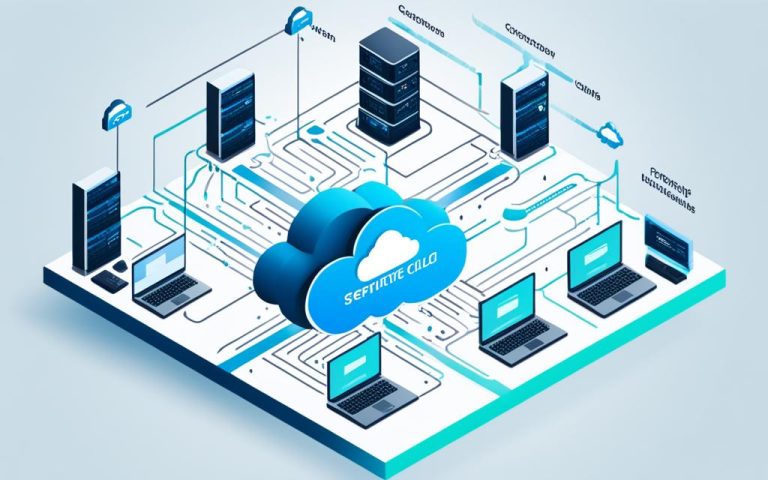Welcome to our guide on designing hybrid cloud solutions for optimal performance. In today’s rapidly evolving digital landscape, businesses are increasingly adopting hybrid cloud architectures to leverage the benefits of both on-premises and public cloud environments. This strategic approach allows organizations to combine the flexibility of public clouds with the control and security of private infrastructure.
When designing a hybrid cloud solution, it is crucial to consider various factors such as Hybrid Cloud Design, Optimal Performance, IT infrastructure, and flexibility. By leveraging the right technologies and frameworks, businesses can achieve seamless integration, scalability, and agility while enhancing their overall performance.
Hybrid cloud computing involves a unified platform for managing on-premises, private, and public cloud data and resources. Some popular hybrid cloud platforms include AWS Outposts, Google Cloud Platform, VMware Hybrid Cloud, and Red Hat OpenShift.
Furthermore, hybrid cloud management tools offer resource management, workload orchestration, data integration, data governance, and security functions. Security is a critical consideration, which includes data encryption, identity and access management, security information and event management, and disaster recovery.
In the following sections, we will dive deeper into the key steps and considerations for architecting a hybrid cloud solution that ensures optimal performance, flexibility, and offers a competitive edge in the ever-evolving technology landscape.
Define Your Objectives
Before embarking on the design of a hybrid cloud service model, it is crucial to clearly define the objectives of your business. By identifying your business goals, challenges, and requirements, you can strategically leverage the power of hybrid cloud to drive growth and success.
Consider the various ways in which hybrid cloud can enhance your business:
- Agility: With hybrid cloud design, you can achieve greater agility by quickly scaling resources up or down based on fluctuating demands.
- Innovation: Hybrid cloud provides a dynamic environment that fosters innovation, enabling you to experiment and develop new solutions without disrupting your core operations.
- Customer Experience: Utilizing hybrid cloud can result in improved customer experiences through faster response times, personalized services, and seamless access to resources.
- Compliance: Hybrid cloud design allows you to meet regulatory requirements and data governance standards by strategically placing workloads in the most suitable environment.
- Cost Optimization: By leveraging hybrid cloud services, you can optimize costs by efficiently allocating resources, leveraging pay-as-you-go models, and reducing capital expenditures.
- Security: Hybrid cloud offers robust security measures and access controls, safeguarding your data and applications from potential threats.
Once your objectives have been defined, align them with your overall cloud strategy. This alignment will help guide your decision-making process when selecting hybrid cloud services and providers that best suit your organization’s needs and goals.
Key Objectives of Hybrid Cloud Design
| Objectives | Description |
|---|---|
| Agility | Enable rapid resource scaling to meet changing demands |
| Innovation | Foster a dynamic environment for experimentation and development |
| Customer Experience | Improve customer interactions and service delivery |
| Compliance | Ensure adherence to regulatory requirements and data governance standards |
| Cost Optimization | Efficiently allocate resources and reduce capital expenditures |
| Security | Protect data and applications against potential threats |
As you can see, defining your objectives and aligning them with your cloud strategy is a critical step in designing a successful hybrid cloud architecture. By doing so, you can ensure that your hybrid cloud solution meets your business goals, enhances operational efficiency, and paves the way for future growth and innovation.
Assess Your Workloads
When designing a hybrid cloud solution, it is crucial to assess your existing or planned applications and services to determine their suitability for on-premises or public cloud deployment. Conducting a comprehensive workload assessment allows you to make informed decisions about workload migration strategies, ensuring optimal resource allocation and integration within your hybrid cloud environment.
During the assessment, consider various factors such as:
- Performance: Evaluate how your applications and services perform under different deployment scenarios, and identify any performance bottlenecks that may impact user experience and productivity.
- Scalability: Determine whether your workloads can scale effectively in a hybrid cloud environment, accommodating fluctuating demands without compromising performance.
- Data Sensitivity: Assess the sensitivity of your data and identify any specific requirements for data protection, confidentiality, and compliance with industry regulations.
- Cost: Consider the financial implications of workload placement decisions, including the potential cost savings or cost escalations associated with on-premises or public cloud deployment.
To evaluate workload placement options, it is beneficial to apply the 7Rs of migration:
- Rehosting
- Re-platforming
- Repurchasing
- Refactoring
- Relocating
- Retiring
- Retaining
By categorizing workloads based on these migration strategies, you can gain insights into the compatibility of each workload with different deployment models, making it easier to plan your hybrid cloud design accordingly.
Here’s an example of how workload assessment and migration strategies could be represented in a table:
| Workload | Migration Strategy |
|---|---|
| CRM System | Re-platforming |
| Email Server | Rehosting |
| E-commerce Platform | Refactoring |
| File Storage | Retaining |
By mapping your workloads to the appropriate migration strategies, you can determine the most suitable deployment models for each workload, ensuring efficient resource allocation and compatibility within your hybrid cloud environment.

Choose Your Cloud Providers
When it comes to designing a hybrid cloud solution, selecting the right cloud providers is crucial. Consideration should be given to the services offered, cost, performance, compatibility, reliability, security, and support provided by different providers. By carefully evaluating these factors, you can ensure that the chosen cloud providers align with your workloads and objectives.
There are different types of cloud services offered by providers, including:
- Infrastructure as a service (IaaS): This service provides virtualized computing resources, such as virtual machines, storage, and networks, enabling you to build and manage your own applications and services.
- Platform as a service (PaaS): With PaaS, providers offer a platform to build, deploy, and manage applications without the need for infrastructure management. This allows developers to focus on coding without worrying about underlying infrastructure.
- Software as a service (SaaS): SaaS providers deliver fully functional software applications over the internet, eliminating the need for installation and maintenance. This enables users to access applications through a web browser.
When choosing cloud providers, it’s important to consider your specific requirements and objectives. Factors such as control, customization, development speed, and ease of access should be taken into account. Additionally, compatibility between your existing systems and the chosen providers should be evaluated to ensure smooth integration and interoperability.
Below is a table showcasing different cloud providers and their key features:
| Cloud Provider | Services | Cost | Performance | Compatibility | Reliability | Support |
|---|---|---|---|---|---|---|
| Amazon Web Services (AWS) | IaaS, PaaS, SaaS | Flexible pricing options | High-performance infrastructure | Wide range of compatibility | Industry-leading reliability | 24/7 customer support |
| Microsoft Azure | IaaS, PaaS, SaaS | Pay-as-you-go pricing | Scalable infrastructure | Integration with Microsoft products | Enterprise-grade reliability | 24/7 customer support |
| Google Cloud Platform (GCP) | IaaS, PaaS, SaaS | Pay-as-you-go pricing | High-performance infrastructure | Integration with Google services | Global network of data centers | 24/7 customer support |
| IBM Cloud | IaaS, PaaS, SaaS | Flexible pricing options | Reliable infrastructure | Integration with IBM services | Enterprise-grade reliability | 24/7 customer support |
Table: Cloud Providers and Key Features
By carefully evaluating the offerings and features of different cloud providers, you can select the ones that best suit your hybrid cloud design and meet your specific requirements.
Design Your Architecture
In hybrid cloud design, architecture plays a crucial role in ensuring the optimal performance of your IT infrastructure. It involves carefully considering the network, storage, compute, and security aspects to create a robust and scalable system.
To achieve high performance, availability, and scalability, it is essential to design an architecture that meets your specific requirements. This includes selecting the right combination of on-premises and cloud resources, leveraging the strengths of each platform while addressing potential bottlenecks.
Security should be a top priority in your hybrid cloud architecture. Implementing strong identity and access management processes, data protection measures, and monitoring tools will help safeguard your sensitive information. Additionally, defining governance policies ensures compliance with regulatory standards.
Enhancing connectivity and operational efficiency can be achieved through the use of VPNs, gateways, APIs, encryption, firewalls, and automation tools. These technologies not only improve network performance but also provide robust security controls for data in transit and at rest.
FAQ
What is hybrid cloud computing?
Hybrid cloud computing is a unified platform that allows businesses to manage their on-premises, private, and public cloud data and resources.
What are some common hybrid cloud platforms?
Common hybrid cloud platforms include AWS Outposts, Google Cloud Platform, VMware Hybrid Cloud, and Red Hat OpenShift.
What functions do hybrid cloud management tools offer?
Hybrid cloud management tools offer resource management, workload orchestration, data integration, data governance, and security functions.
What does hybrid cloud security involve?
Hybrid cloud security includes data encryption, identity and access management, security information and event management, and disaster recovery.
How do I design a hybrid cloud service model?
Before designing a hybrid cloud service model, it’s important to define your business goals, challenges, and requirements. Determine how hybrid cloud can improve agility, innovation, customer experience, compliance, cost optimization, and security. Align your objectives with your cloud strategy and choose the right hybrid cloud services and providers based on your needs.
How do I assess my workloads for hybrid cloud deployment?
Assess your existing or planned applications and services to determine their suitability for on-premises or public cloud deployment. Consider factors such as performance, scalability, data sensitivity, compliance, and cost. Use the 7Rs of migration (rehosting, re-platforming, repurchasing, refactoring, relocating, retiring, retaining) to evaluate workload placement options. Make informed decisions on workload migration strategies to ensure optimal resource allocation and integration.
How do I choose the right cloud providers for my hybrid cloud?
Select cloud providers based on their services, cost, performance, compatibility, reliability, security, and support. Consider infrastructure as a service (IaaS), platform as a service (PaaS), and software as a service (SaaS) offerings. Choose providers that align with your workloads and objectives. Consider factors like control, customization, development speed, and ease of access.
How do I design my hybrid cloud architecture?
Design your hybrid cloud architecture considering network, storage, compute, and security aspects. Ensure performance, availability, scalability, and resilience of your architecture.
What governance policies are important for hybrid cloud?
Define governance policies and processes for identity and access management, data protection, monitoring, and compliance.
What tools can I use to enhance hybrid cloud connectivity and security?
Use VPNs, gateways, APIs, encryption, firewalls, and automation tools to enhance connectivity, security, and operational efficiency.




















Это полное бесчинство! ПК Бествей не нарушал закон, в отличии от некоторых! Наш кооператив – это путь к своему жилью, освобождение от ипотечных обязательств. Мы, пайщики, объединили свои усилия и средства, чтобы обеспечить себе и своим семьям крышу над головой, мечту о собственной квартире. И где здесь криминал? Мы лишь стремились к своей цели, проложив путь через кооператив, который предоставлял нам возможность приобрести квартиры под 0 процентов! И как нам не подумать о том, что в этой игре замешаны влиятельные силы? Видимо, чьи-то интересы оказались выше законности и справедливости. Наше будущее, наши семьи стоят того, чтобы мы продолжали бороться за справедливость и наши права. Мы требуем, чтобы следственные органы прекратили свои действия, основанные на незаконных поступках и произволе. Я надеюсь, что вскоре настанет время, когда наши мечты станут реальностью, когда наше право на собственное жилье будет восстановлено, а те, кто незаконно попытался нас лишить этого права, будут наказаны по всей строгости закона.
Матвей
Hi there
Just checked your technetworks.ca baclink profile, I noticed a moderate percentage of toxic links pointing to your website
We will investigate each link for its toxicity and perform a professional clean up for you free of charge.
Start recovering your ranks today:
https://www.hilkom-digital.de/professional-linksprofile-clean-up-service/
Regards
Mike Fleming
Hilkom Digital SEO Experts
https://www.hilkom-digital.de/